Exploring the Various Types of Granite Monuments: A Comprehensive Guide
Granite monuments have long stood as enduring symbols of permanence, resilience, and respect for loved ones. Whether crafted as gravestones, memorials, or commemorative structures, granite beautifully blends strength with elegance, making it a preferred material for lasting tributes. Furthermore, its exceptional durability, variety of colors, and refined surface finishes make granite a timeless choice for memorialization. In this article, we will explore the different types of granite monuments, examine their unique characteristics, and discuss why granite continues to be the material of choice for families, architects, and designers around the world.
The Beauty of Granite
Granite is an igneous rock that forms when magma cools and solidifies deep beneath the Earth's surface. This natural formation process produces a dense and durable material admired for its resistance to weathering, scratches, and fading. As a result, granite has become an ideal choice for monuments that are built to endure the test of time. Its mineral composition — primarily feldspar, quartz, and mica — creates distinctive patterns that vary in color, texture, and overall design, giving each piece a one-of-a-kind appearance.
Moreover, granite monuments can range from simple headstones to majestic statues and commemorative markers, each crafted with care and precision based on the type of granite used. Thanks to this diversity, families, architects, and designers can choose styles that reflect their vision, whether they prefer a classic, traditional design or a sleek, modern aesthetic.
Types of Granite Monuments
1.Black Granite
Black granite is one of the most striking and elegant varieties among all granite types. It is renowned for its deep, solid black hue, which may display subtle tonal variations depending on the quarry source. Additionally, black granite is often highly polished, resulting in a glossy, reflective surface that enhances the visibility of inscriptions and engravings. Because of its powerful and timeless appeal, many families and designers prefer black granite for memorials, as it beautifully conveys a sense of dignity, solemnity, and reverence.
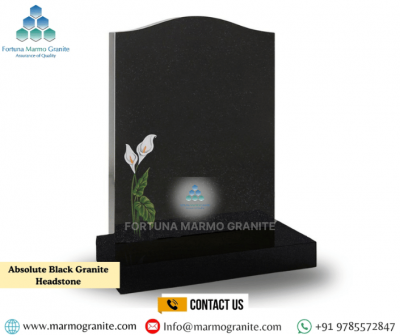
Features of Black Granite Monuments:
- Sleek, polished appearance
- High contrast for inscriptions, making them easy to read
- Provides a formal and dignified look
- Highly resistant to weathering and fading
2.Sierra Grey Granite Headstone
Gray granite is the most commonly used variety in monument construction, offering a more subtle and understated appearance compared to black granite. The color can range from light to dark gray, with some varieties exhibiting specks of black or white throughout. Gray granite provides a neutral background for text and artwork, making it suitable for memorials that blend into natural surroundings.
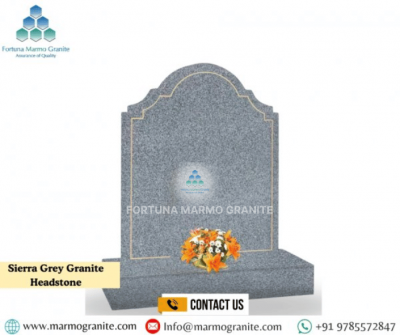
Features of Gray Granite Monuments:
- Moreover, Versatile and timeless color
- In addition, Durable and highly weather-resistant
- Yet, Perfect for inscriptions and carving artwork
- In contrast, Commonly used in a wide variety of memorial styles
3.White Granite
White granite is a lighter, brighter option that exudes purity and simplicity. It is often chosen for its elegant and clean appearance, giving it a dignified yet approachable look. While white granite tends to be more prone to showing dirt and stains than darker types, it remains an excellent choice for those seeking a light and airy memorial.
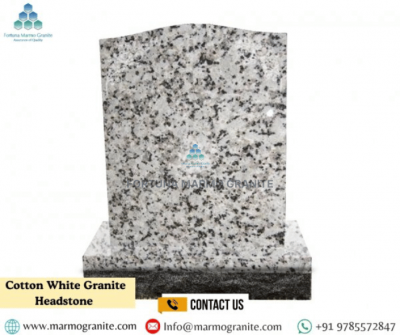
Features of White Granite Monuments:
- Bright and elegant appearance
- Soft and classic aesthetic
- Ideal for serene and peaceful memorials
- Can be easily polished to a smooth finish
4.Red Granite
Red granite is another striking and bold choice for monuments. It ranges from deep crimson to lighter shades of red, often featuring unique flecks and veins of different colors. Red granite can create an eye-catching and vibrant memorial, making it a popular choice for those looking for something distinctive and memorable.
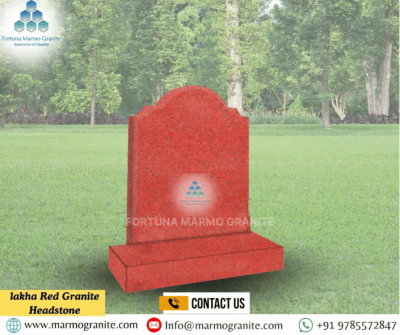
Features of Red Granite Monuments:
- Bold, warm colors that stand out
- Rich patterns and textures
- Highly durable and resistant to weathering
- Adds a personal touch to memorials
5.Blue Granite
Blue granite, while less common than other types, offers a striking and unique option for memorials. This granite is known for its subtle blue tones, which can vary from a pale, almost silvery shade to a deep, midnight blue. The unique color of blue granite evokes a sense of calm and tranquility, making it a popular choice for those who want a memorial that is both serene and unusual.
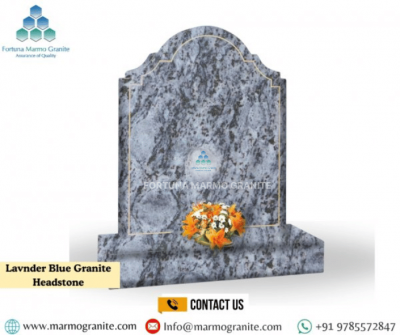
Features of Blue Granite Monuments:
- Moreover, Unique and peaceful blue tones
- In addition, Excellent for creating calming memorials
- Yet, Works well with etching and detailed carving
- In contrast, Less prone to weathering than some lighter granite types
6.Brown and Tan Granite
Brown and tan granites are another option for those looking for earthy tones in their memorials. These colors typically have rich, warm undertones, with veins of gold, orange, and deep browns running through them. These granites are an excellent choice for memorials that need to blend seamlessly with natural landscapes.
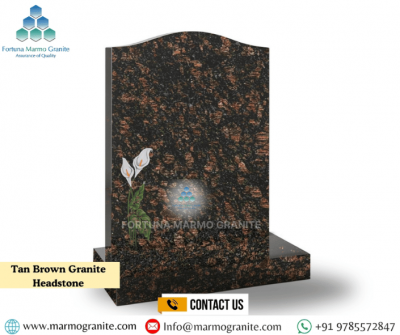
Features of Brown and Tan Granite Monuments:
- Moreover, Warm and earthy colors
- In addition, Great for blending into natural environments
- Yet, Durable and resistant to weathering
- In contrast, Suitable for rustic or nature-inspired designs
Customizing Granite Monuments
Common Customization Options for Granite Monuments:
- Inscriptions: Moreover, Names, dates, and special messages can be engraved on the monument, often using different fonts and styles to create a distinctive look.
- Carvings and Etchings: In addition, Custom carvings of religious symbols, personal images, or nature scenes can be etched into the stone, adding a personal touch to the memorial.
- Shapes and Sizes: Yet, Granite monuments come in a variety of shapes and sizes, from traditional upright headstones to benches, plaques, and statues. Families can choose the size and style that best fits their needs and space.
- Color and Finish: In contrast, The finish of the granite can also be customized, with options for polished, honed, or rough-hewn surfaces, each contributing to the overall look and feel of the monument.
Conclusion
Choosing a granite monument is a deeply personal and meaningful decision. It goes beyond simply selecting a stone — it's about creating a lasting tribute that honors the life, legacy, and personality of your loved one. Moreover, granite's natural strength, timeless beauty, and diverse range of colors and textures make it an ideal material for memorials that stand the test of time. Ultimately, a granite monument serves as an enduring canvas of love and remembrance, symbolizing respect, memory, and eternal connection.
From classic upright monuments to more contemporary designs, the possibilities are virtually limitless. Fortuna Marmo Granite Our team understands the importance of this meaningful journey and is fully committed to guiding you every step of the way. With years of experience, we work closely with you to understand your vision, explore the diverse range of granite options, and help you choose the perfect design to honor your loved one's memory. Moreover, we believe that a well-crafted granite monument is far more than just a stone — it is a symbol of enduring love, a place of comfort and reflection, and a lasting connection to those we cherish.

